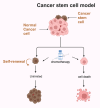Molecular mechanisms and therapeutic strategies in overcoming chemotherapy resistance in cancer
- PMID: 39757310
- PMCID: PMC11700966
- DOI: 10.1186/s43556-024-00239-2
Molecular mechanisms and therapeutic strategies in overcoming chemotherapy resistance in cancer
Abstract
Cancer remains a leading cause of mortality globally and a major health burden, with chemotherapy often serving as the primary therapeutic option for patients with advanced-stage disease, partially compensating for the limitations of non-curative treatments. However, the emergence of chemotherapy resistance significantly limits its efficacy, posing a major clinical challenge. Moreover, heterogeneity of resistance mechanisms across cancer types complicates the development of universally effective diagnostic and therapeutic approaches. Understanding the molecular mechanisms of chemoresistance and identifying strategies to overcome it are current research focal points. This review provides a comprehensive analysis of the key molecular mechanisms underlying chemotherapy resistance, including drug efflux, enhanced DNA damage repair (DDR), apoptosis evasion, epigenetic modifications, altered intracellular drug metabolism, and the role of cancer stem cells (CSCs). We also examine specific causes of resistance in major cancer types and highlight various molecular targets involved in resistance. Finally, we discuss current strategies aiming at overcoming chemotherapy resistance, such as combination therapies, targeted treatments, and novel drug delivery systems, while proposing future directions for research in this evolving field. By addressing these molecular barriers, this review lays a foundation for the development of more effective cancer therapies aimed at mitigating chemotherapy resistance.
Keywords: Apoptosis evasion; Cancer stem cells; Chemotherapy resistance; Epigenetic modifications; Molecular mechanisms; Targeted therapy.
© 2025. The Author(s).
Conflict of interest statement
Declarations. Ethics approval and consent to participate: Not applicable. Consent for publication: Not applicable. Competing interests: The authors declare no conflict of interest.
Figures





Similar articles
-
Surmounting cancer drug resistance: New insights from the perspective of N6-methyladenosine RNA modification.Drug Resist Updat. 2020 Dec;53:100720. doi: 10.1016/j.drup.2020.100720. Epub 2020 Aug 20. Drug Resist Updat. 2020. PMID: 32892147 Review.
-
Insights into new mechanisms and models of cancer stem cell multidrug resistance.Semin Cancer Biol. 2020 Feb;60:166-180. doi: 10.1016/j.semcancer.2019.07.022. Epub 2019 Jul 29. Semin Cancer Biol. 2020. PMID: 31369817 Review.
-
Mechanisms and Strategies to Overcome Drug Resistance in Colorectal Cancer.Int J Mol Sci. 2025 Feb 25;26(5):1988. doi: 10.3390/ijms26051988. Int J Mol Sci. 2025. PMID: 40076613 Free PMC article. Review.
-
Nanomedicine for targeted cancer therapy: towards the overcoming of drug resistance.Drug Resist Updat. 2011 Jun;14(3):150-63. doi: 10.1016/j.drup.2011.01.003. Epub 2011 Feb 16. Drug Resist Updat. 2011. PMID: 21330184 Review.
-
Potential Strategies for Overcoming Drug Resistance Pathways Using Propolis and Its Polyphenolic/Flavonoid Compounds in Combination with Chemotherapy and Radiotherapy.Nutrients. 2024 Oct 31;16(21):3741. doi: 10.3390/nu16213741. Nutrients. 2024. PMID: 39519572 Free PMC article. Review.
Cited by
-
Repurposing fluoroquinolones as cancer chemosensitizers: a way to overcome cancer therapeutic bottleneck.Naunyn Schmiedebergs Arch Pharmacol. 2025 Aug 11. doi: 10.1007/s00210-025-04508-x. Online ahead of print. Naunyn Schmiedebergs Arch Pharmacol. 2025. PMID: 40788483 Review.
-
Overcoming resistance mechanisms in cancer immunotherapy-novel approaches and combinations.Naunyn Schmiedebergs Arch Pharmacol. 2025 Jun 11. doi: 10.1007/s00210-025-03963-w. Online ahead of print. Naunyn Schmiedebergs Arch Pharmacol. 2025. PMID: 40498093 Review.
-
Unveiling the anticancer potential of Pinostrobin: mechanisms of action, pharmacokinetic insights, and therapeutic prospects.Med Oncol. 2025 Jun 17;42(7):269. doi: 10.1007/s12032-025-02827-w. Med Oncol. 2025. PMID: 40526217 Review.
-
Lipid rafts: novel therapeutic targets for metabolic, neurodegenerative, oncological, and cardiovascular diseases.Lipids Health Dis. 2025 Apr 17;24(1):147. doi: 10.1186/s12944-025-02563-0. Lipids Health Dis. 2025. PMID: 40247292 Free PMC article. Review.
-
Metabolomics in Breast Cancer: From Biomarker Discovery to Personalized Medicine.Metabolites. 2025 Jun 23;15(7):428. doi: 10.3390/metabo15070428. Metabolites. 2025. PMID: 40710528 Free PMC article. Review.
References
-
- Sung H, Ferlay J, Siegel RL, Laversanne M, Soerjomataram I, Jemal A, et al. Global Cancer Statistics 2020: GLOBOCAN Estimates of Incidence and Mortality Worldwide for 36 Cancers in 185 Countries. CA Cancer J Clin. 2021;71(3):209–49. 10.3322/caac.21660. - PubMed
-
- Bray F, Laversanne M, Weiderpass E, Soerjomataram I. The ever-increasing importance of cancer as a leading cause of premature death worldwide. Cancer. 2021;127(16):3029–30. 10.1002/cncr.33587. - PubMed
-
- Krell RW, Wei AC. Gallbladder cancer: surgical management. Chin Clin Oncol. 2019;8(4):36. 10.21037/cco.2019.06.06. - PubMed
-
- Hickman L, Contreras C. Gallbladder Cancer: Diagnosis, Surgical Management, and Adjuvant Therapies. Surg Clin North Am. 2019;99(2):337–55. 10.1016/j.suc.2018.12.008. - PubMed
-
- Vogel A, Bridgewater J, Edeline J, Kelley RK, Klümpen HJ, Malka D, et al. Biliary tract cancer: ESMO Clinical Practice Guideline for diagnosis, treatment and follow-up. Ann Oncol. 2023;34(2):127–40. 10.1016/j.annonc.2022.10.506. - PubMed
Publication types
MeSH terms
Substances
LinkOut - more resources
Full Text Sources
Medical
